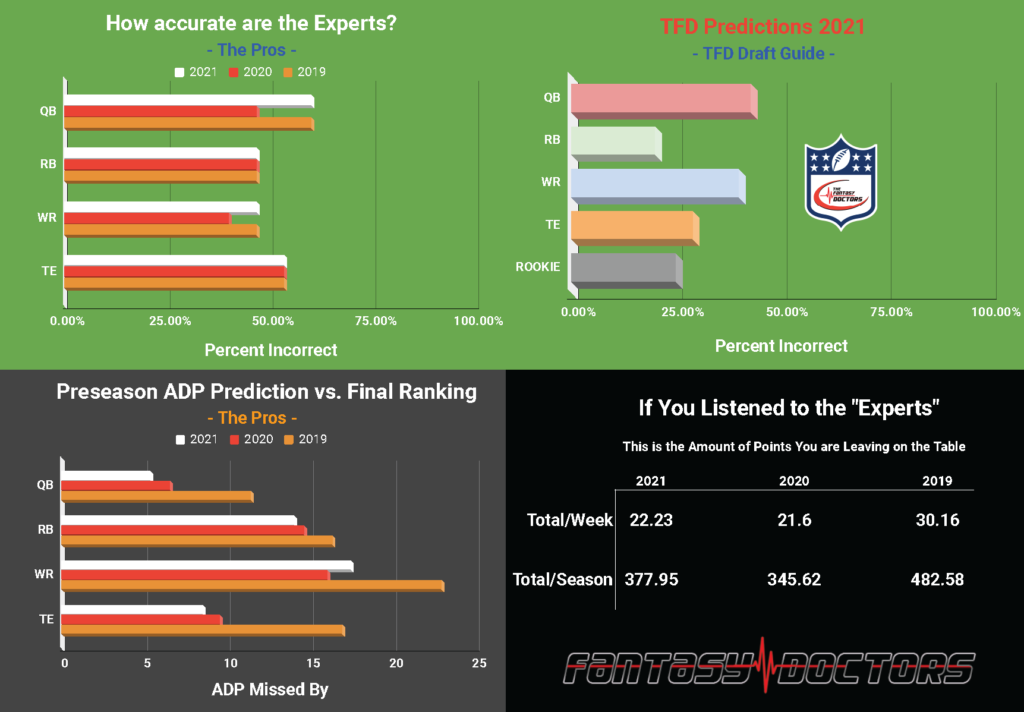
Are fantasy experts actually “experts”? That was the question we sought to ask when first collecting data for the figures above. First, we found how each expert ranked the top 15 players by position over the past 3 years, and the data was compared to the actual final year ADP (Bottom Left graph). Then for each skill position (WR/RB) we decided to mark every time the expert was off by >10, it was considered “wrong,” and for QB/TE the cutoff was 5 (because fewer are ranked). This data can be found in the top left graph for the “experts” and top right graph for TFD for comparison. Finally, we then collected the data and calculated how many fantasy points you would be missing out on each week and season by using the experts ADP over TFD ADP (found in the bottom right table).
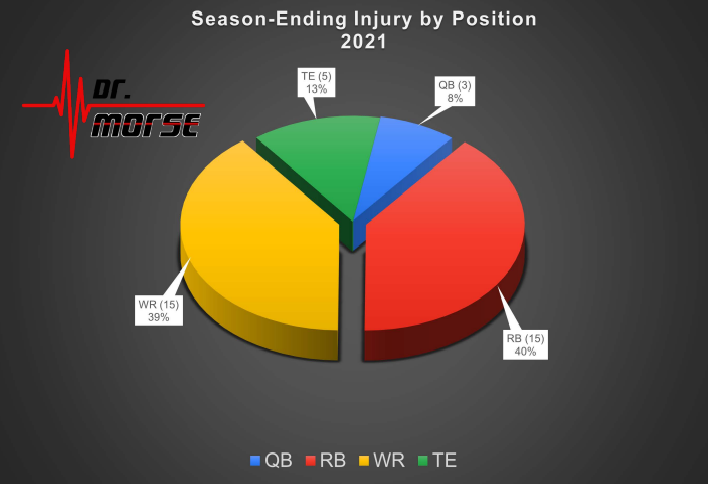


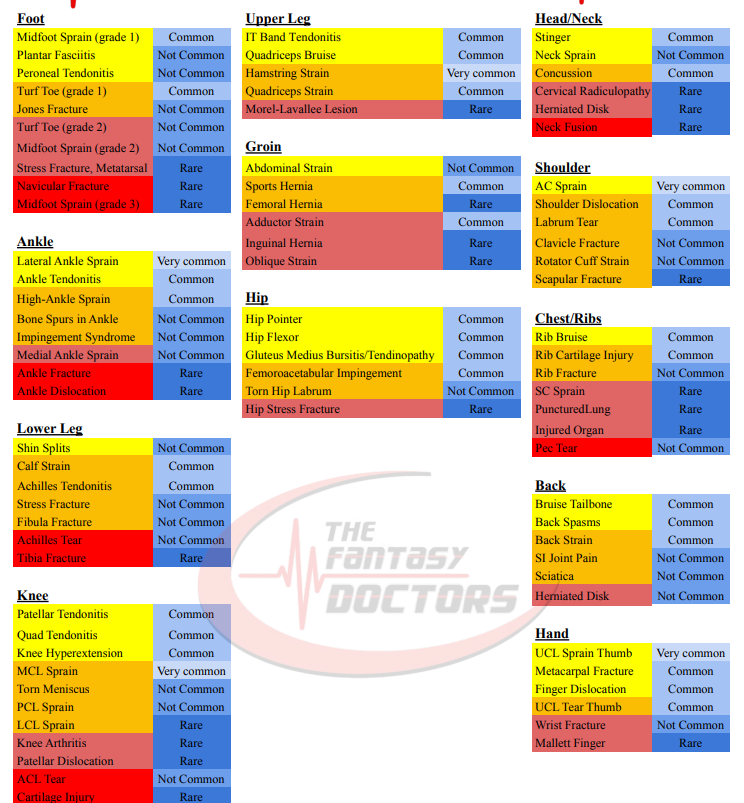
There are several studies that have extensively analyzed NFL players injuries and come to several different conclusions. Some of these studies are discussed and summarized, separated by body part, below.
Study link: https://pubmed.ncbi.nlm.nih.gov/27793805/
Recent Example: Trevor Lawrence (2021)
Study link: https://pubmed.ncbi.nlm.nih.gov/28974332/
Study link: https://pubmed.ncbi.nlm.nih.gov/28350487
Recent Example: Travis Etienne (2021)
Study link: https://pubmed.ncbi.nlm.nih.gov/27166291/
Study link: https://pubmed.ncbi.nlm.nih.gov/29152997/
Recent Example: Derrick Henry (2021)
Study link: https://pubmed.ncbi.nlm.nih.gov/26353796/
Recent Example: Irv Smith Jr. (2021)
Study link: https://pubmed.ncbi.nlm.nih.gov/24914032/
Exceptions: Travis Kelce, Melvin Gordon
Current player returning from chondroplasty: Raheem Mostert
Study link: https://pubmed.ncbi.nlm.nih.gov/25573391/
Interesting Injury-Related Statistics
Running Back Injury Statistics as it Relates to Career Workload College and NFL
We took a total of 68 running backs currently in the NFL and the recently drafted rookies and analyzed the total number of total touches (rushes + catches) over the course of their college and NFL careers and compared them to the total number of games missed due to injury. Here’s what we found:
As you can see there are only four current running backs with over 2000 career touches (Mark Ingram, Ezekiel Elliott, Melvin Gordon, and Derrick Henry) Three of these four, excluding Zeke, all missed at least 10 games in their career, with Ingram missing 27. Remarkably Ezekiel Elliott for almost having a total of 2600 career touches is a unicorn, a massive exception to the rule, and has only missed ONE career game due to injury, which is simply amazing.
Zooming out you can see that as the number of touches starts to increase so does the total number of games missed, which makes sense. There are two players that stand out from the group who have missed many more games than the rest, Raheem Mostert and Chris Carson.
Trying to identify a trend, you can see missing over 10 games with under 1000 touches puts you above average for games missed, and over 15 games missed when that total career touch is about 1750. The threshold for longevity as an RB in the NFL seems to be around 1800 career combined touches between college and the NFL. Not many players make it to this number, and the ones that do are all elite.
Average and eventually replaced RBs rarely make it to over 1250 touches based on the current sample size. A large season-ending injury like a torn ACL or a torn Achilles substantially increases the number of games missed, as expected, and usually shortens one’s career. Missing 10+ games in one season, or in multiple seasons usually ends an RB’s career. Of the current players analyzed with over 1750 touches, the only one that has torn his ACL or Achilles is Dalvin Cook, and Saquon Barkley should join them this year.
There are certain players that are very good at avoiding significant injuries and missing games, you will see them below the red line. These players collectively have a lower risk score for missing games based on their history.
The group of players on the bottom left-hand corner with near zero games missed and less than 750 touches are all the current rookies entering the NFL. That should change in 1-2 years.
Digging deeper, we have identified that there are only 9 current NFL running backs with over 1000 career touches and less than 10 games missed due to injury. Elliott, Ekeler, Taylor, Montgomery, Robinson, Singletary, Dillon, Harris and Mattison.
This represents an elite group of players who have been able to accumulate a massive volume of touches without sustaining a large injury. The exception to this rule is obviously James Robinson who tore his Achilles late in 2021.
I want to point out 3 players that have been remarkably healthy for the number of touches they have endured. Najee Harris, Jonathan Taylor, and Ezekiel Elliott have all either missed zero or one game despite accumulating over 1000 touches each (Zeke has almost 2600 career touches).
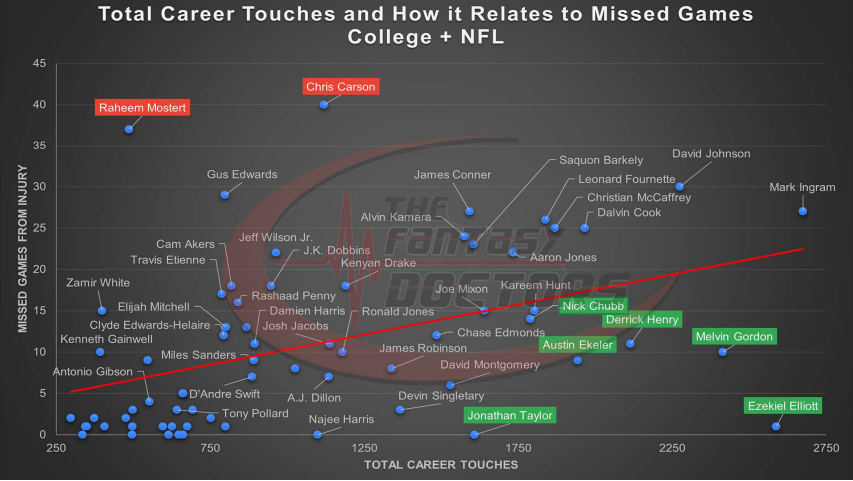
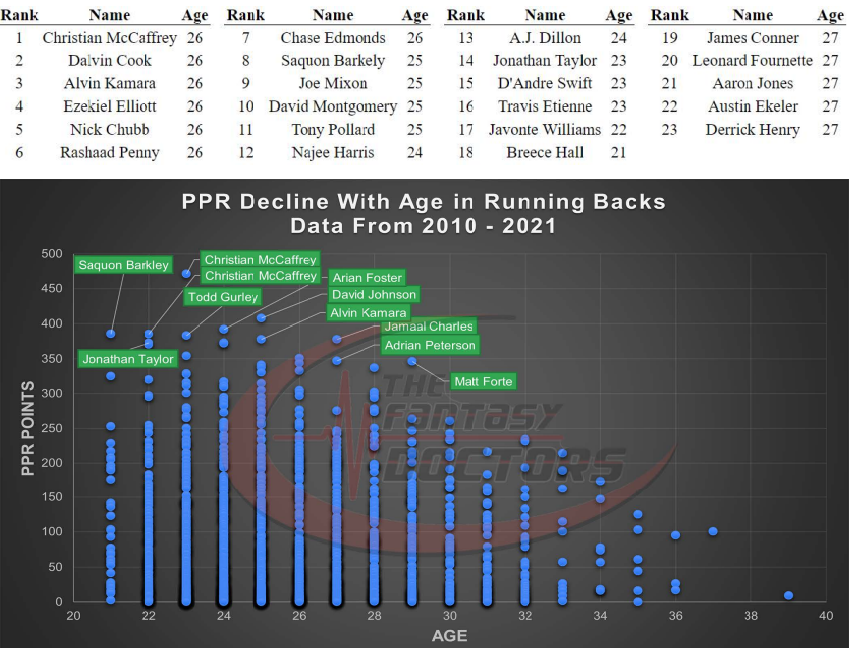
As we try to decipher what age a running back starts to peak and also start to decline, we have plotted out all of the running backs from 2010 to the 2021 season in the NFL. Using PPR points, plotting out each player by age and identifying those that stand out.
As you can see the only player that has reached over 450 PPR points in a single season of the past 11 years is Christian McCaffrey in his monster 2019 season, when he was 23 years old. What you don’t see on this chart is his age 24 and 25 seasons which have been each of the past two years, where he has played a total of 10 out of 33 games missing 70% of games due to injury.
The majority of the monster seasons seem to happen between 22 and 27 years old. It is rare for a player to score more than 350 PPR points in a season over the age of 27. For context, Jonathan Taylor scored 369 PPR points in 2021 and finished at the RB1.
In 2021 a player needed to score at least 227 PPR points in order to be a top 10 running back. That number jumped to 300+ points to be in the top three. As you can see, nearly every single player over the past 11 years who has scored over 300 points is between the age of 22 and 26. That is your window for success.
If you were trying to identify which players have top 10 potential in PPR this upcoming season you can use this chart and add it to our list of running backs who are in the age ranges of 22 to 26, which have been identified as the greatest chance of a prime season.
This is a total of 38 current NFL running backs. Identifying players that are not coming off major soft-tissue injuries (ACL, Achilles), and players that are expected to get the majority of touches in their offense we see there is a list of approximately 18 players.
There are that still technically fit this criteria that we can add as well (Connor, Fournette, Jones, Ekeler and Henry).
hat gives us a total of 23 players that fit the criteria for age and expected volume. We can add this with our risk scores which takes it into consideration past medical history to further narrow down the list.
There are a couple other players that could potentially fit into this window that stick out to me including Elijah Mitchell, Rhamondre Stevenson and Josh Jacobs.
When you add this information to the running back chart that correlates total number of touches in college in the NFL to total number of games missed you will start to identify a pattern.
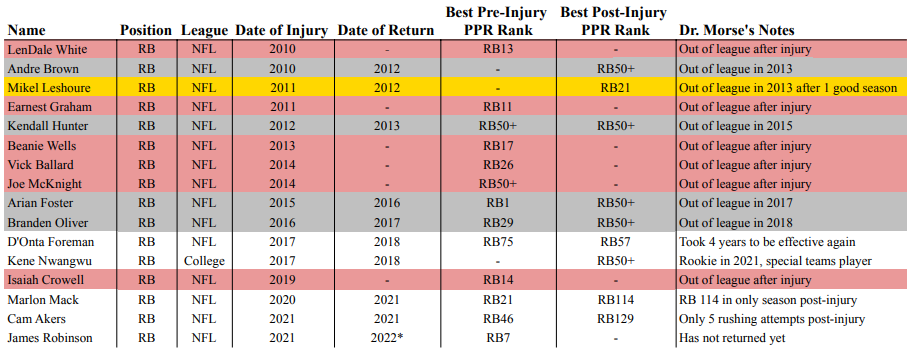
Achilles injuries have been a particularly awful injury, particularly for RBs. If you go back to 2010, 16 RBs have suffered Achilles tears, 15 in the NFL and 1 in college that made it to the NFL. As of this writing, 11 of the 16 RBs careers have ended. 6 of the 11 (55%) RBs careers ended due to the injury and 4 of the remaining 5 (36%) only played 1 more NFL season.
That means that 91% of the RBs who suffered Achilles tears from 2010 to 2016, all of their careers ended within 1 season of their injury. Of the players that were able to return after the injury, only 20% (1/5) posted a respectable season after the injury (Mikel Leshoure, 2012) where he finished as RB21. The remaining 80% finished at lease RB50 or worse, and their careers ended shortly thereafter.
There has been one exception to the rule so far. That is D’Onta Foreman, who tore his Achilles in 2017 but wasn’t effective in the NFL until 2021, where he filled in for Derrick Henry after his Jones fracture, but he only averaged 10.2 fantasy PPG.
This doesn’t bode well for Marlon Mack, who returned in 2021, Cam Akers who miraculously returned after 5.5 months but was ineffective in the playoffs. He rushed 67 times for a total of 172 yards (3.9 YPC), for comparison he averaged 4.3 YPC in his rookie season. As far as James Robinson, unless he is the exception to the rule, this injury doesn’t bode well for him in 2022.
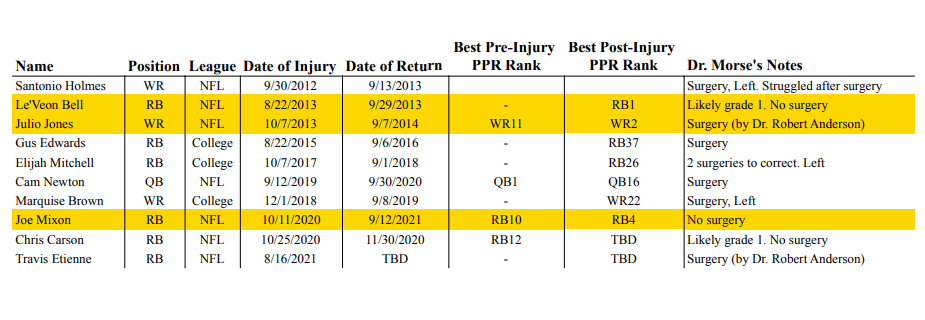
Lisfranc injuries are serious injuries but the effects are predominately short-term. Some of the greatest fantasy-players over the past 10 years suffered both mild and severe Lisfranc sprains, requiring surgery (Julio Jones) and those who didn’t (Le’Veon Bell), and went on to Hall of Fame careers. Unlike soft tissue injuries (Achilles, ACL), Lisfranc is a fracture, and as you can see it has not been a ‘death sentence’ for NFL players after they return from the injury. This is fantastic news, particularly for Travis Etienne.
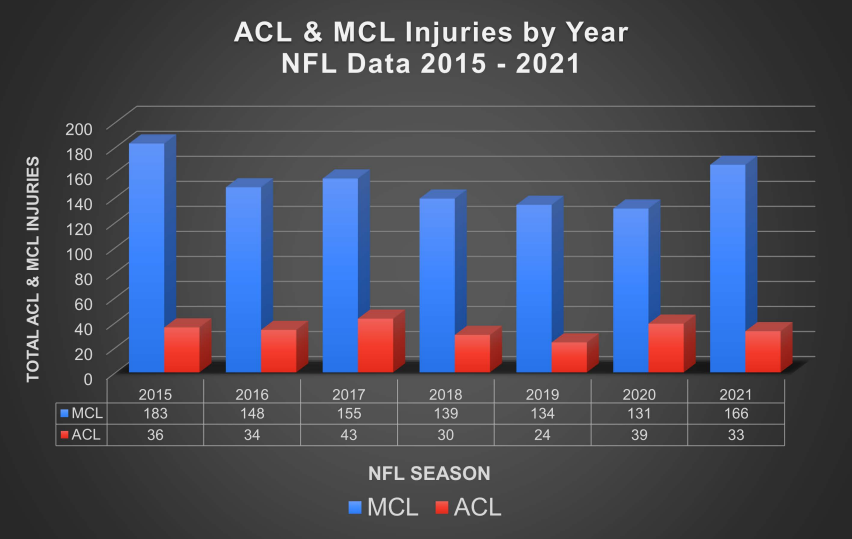
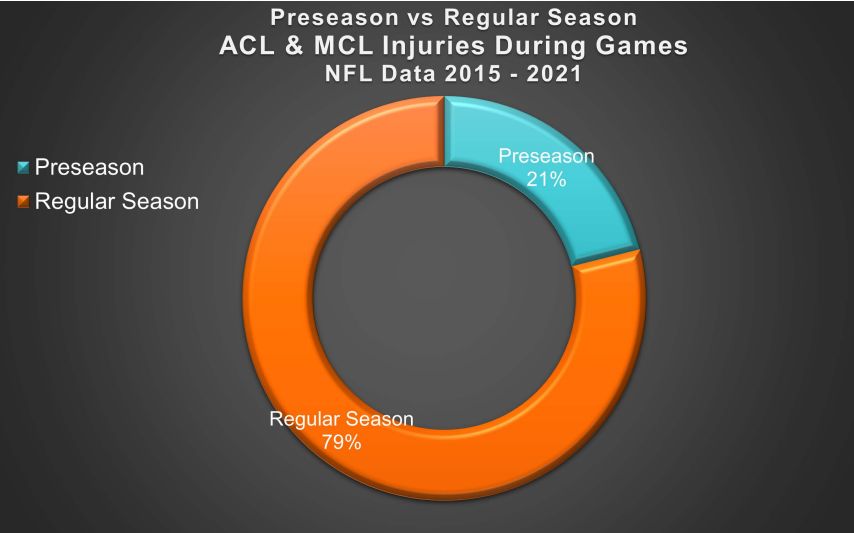
Concussions
In 2021 Edwin Porras, DPT (@FBInjuryDoc) calculated concussion rates and recurrences from 2016 to 2019 based on injury reports.
After reviewing the data, here’s the conclusions I have made.
There is a 42% chance that a player will not miss a game with his first concussion, and a 42% chance he will only miss 1 game. That means there is an 84% chance that a player suffering his first concussion will only miss 0 or 1 game.
For a player with a history of concussions, there is a 26% chance of not missing a game, and a 36% chance of only missing 1 game. Combined that 62% chance of a player with a history of concussions, will only miss a maximum of 1 game after sustaining a new concussion. For players with a significant history of concussions, former TE Jordan Reed comes to mind, there is a 21% chance of missing at least 3 games. Often which ends up becoming a season-ending injury.
Take home Point: Overall, there is about a 75% chance that a player misses a maximum of one game after suffering a concussion, regardless of their concussion history. Here is some data from the NFL from 2015 – 2021 about the rate of concussions
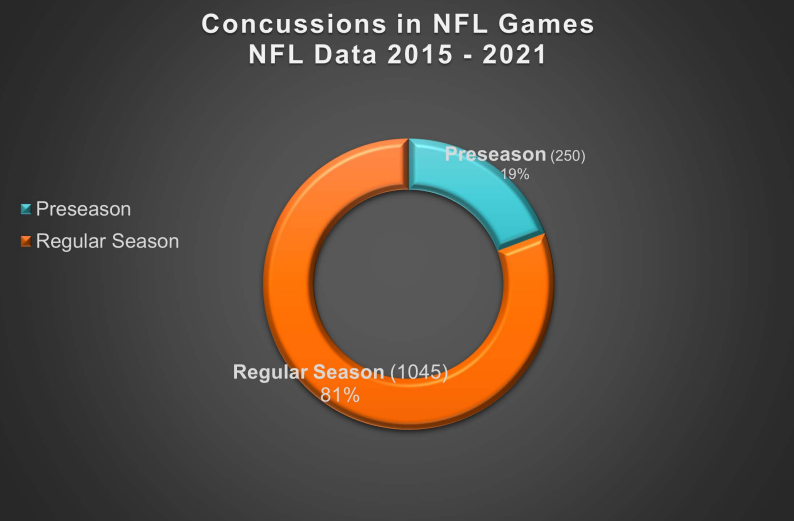
Copyright © 2024 by The Fantasy Doctors, LLC. ALL RIGHTS RESERVED